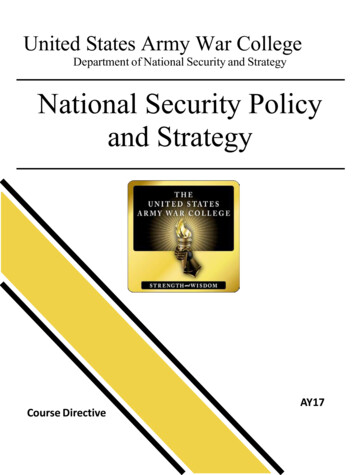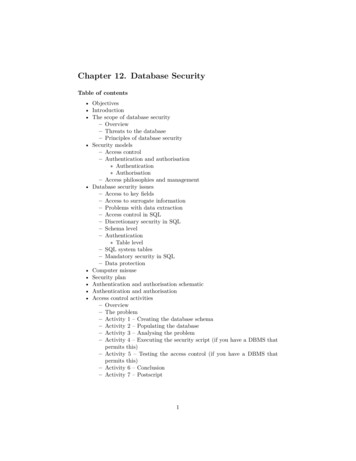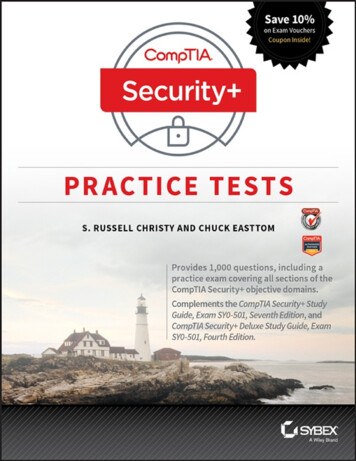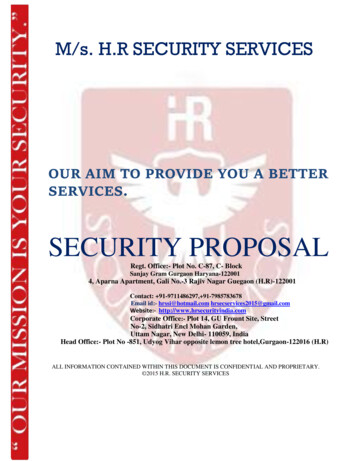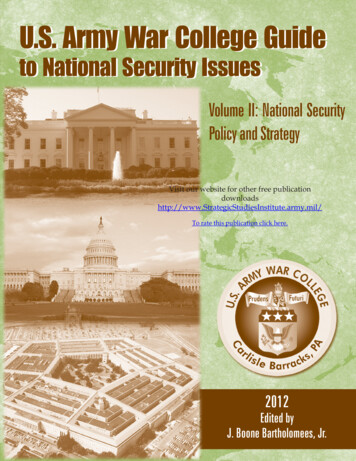
Transcription
U.S. Army War College Guideto National Security IssuesVolume II: National SecurityPolicy and StrategyVisit our website for other free titute.army.mil/To rate this publication click here.2012Edited byJ. Boone Bartholomees, Jr.
Form ApprovedOMB No. 0704-0188Report Documentation PagePublic reporting burden for the collection of information is estimated to average 1 hour per response, including the time for reviewing instructions, searching existing data sources, gathering andmaintaining the data needed, and completing and reviewing the collection of information. Send comments regarding this burden estimate or any other aspect of this collection of information,including suggestions for reducing this burden, to Washington Headquarters Services, Directorate for Information Operations and Reports, 1215 Jefferson Davis Highway, Suite 1204, ArlingtonVA 22202-4302. Respondents should be aware that notwithstanding any other provision of law, no person shall be subject to a penalty for failing to comply with a collection of information if itdoes not display a currently valid OMB control number.1. REPORT DATE3. DATES COVERED2. REPORT TYPEJUN 201200-00-2012 to 00-00-20124. TITLE AND SUBTITLE5a. CONTRACT NUMBERU.S. Army War College Guide to National Security Issues. Volume II:National Security Policy and Strategy5b. GRANT NUMBER5c. PROGRAM ELEMENT NUMBER6. AUTHOR(S)5d. PROJECT NUMBER5e. TASK NUMBER5f. WORK UNIT NUMBER7. PERFORMING ORGANIZATION NAME(S) AND ADDRESS(ES)U.S. Army War College,Strategic Studies Institute,632 WrightAvenue,Carlisle,PA,17013-52449. SPONSORING/MONITORING AGENCY NAME(S) AND ADDRESS(ES)8. PERFORMING ORGANIZATIONREPORT NUMBER10. SPONSOR/MONITOR’S ACRONYM(S)11. SPONSOR/MONITOR’S REPORTNUMBER(S)12. DISTRIBUTION/AVAILABILITY STATEMENTApproved for public release; distribution unlimited13. SUPPLEMENTARY NOTES14. ABSTRACT15. SUBJECT TERMS16. SECURITY CLASSIFICATION OF:a. REPORTb. ABSTRACTc. THIS PAGEunclassifiedunclassifiedunclassified17. LIMITATION OFABSTRACT18. NUMBEROF PAGESSame asReport (SAR)43319a. NAME OFRESPONSIBLE PERSONStandard Form 298 (Rev. 8-98)Prescribed by ANSI Std Z39-18
Strategic Studies Institute BookU. S. ARMY WAR COLLEGE GUIDETO NATIONAL SECURITY ISSUESVOLUME II:NATIONAL SECURITY POLICY AND STRATEGY5th EditionJ. Boone Bartholomees, Jr.EditorJune 2012The views expressed in this report are those of the authors and do not necessarily reflect the official policy or positionof the Department of the Army, the Department of Defense, or the U.S. Government. Authors of Strategic Studies Institute (SSI) publications enjoy full academic freedom, provided they do not disclose classified information, jeopardizeoperations security, or misrepresent official U.S. policy. Such academic freedom empowers them to offer new andsometimes controversial perspectives in the interest of furthering debate on key issues.This report is cleared for publicrelease; distribution is unlimited.*****This publication is subject to Title 17, United States Code, Sections 101 and 105. It is in the public domain and may notbe copyrighted.
*****Comments pertaining to this report are invited and should be forwarded to: Director, Strategic Studies Institute,U.S. Army War College, 47 Ashburn Dr., Carlisle, PA 17013.*****All Strategic Studies Institute (SSI) publications may be downloaded free of charge from the SSI website. Hardcopies of this report may also be obtained free of charge while supplies last by placing an order on the SSI website.SSI publications may be quoted or reprinted in part or in full with permission and appropriate credit given to the U.S.Army Strategic Studies Institute, U.S. Army War College, Carlisle Barracks, PA. Contact SSI by visiting our website atthe following address: www.StrategicStudiesInstitute.army.mil.*****The Strategic Studies Institute publishes a monthly e-mail newsletter to update the national security communityon the research of our analysts, recent and forthcoming publications, and upcoming conferences sponsored by theInstitute. Each newsletter also provides a strategic commentary by one of our research analysts. If you are interestedin receiving this newsletter, please subscribe on the SSI website at .ISBN 1-58487-533-Xii
CONTENTSPart I: The National System and Environment1. American Values, Interests, and Purpose: Perspectives on the Rootsof American Political and Strategic Culture.3Marybeth P. Ulrich2. Crafting National Interests in the 21st Century .13Alan G. Stolberg3. The National Security Community, Revisited .27Walter H. Leach4. Making National Security Policy in the 21st Century .41Alan G. Stolberg5. National Security Powers: Are the Checks in Balance? . 63Marybeth P. Ulrich6. National Military Strategies: A Historical Perspective, 1990 to 2012 . 81Richard M. Meinhart7. Present at the Counterrevolution: An Essay on the 2005 National DefenseStrategy and its Impact on Policy.95Nathan P. Freier8. Securing America From Attack: The Defense Department’s EvolvingRole After 9/11 .107Frank L. JonesPart II: The International System and Environment9. International Order .123Deborah L. Hanagan10. The International System in the 21st Century . 137Alan G. Stolberg11. International Relations Theory and American Grand Strategy .151Janeen M. Klinger12. Multilateralism and Unilateralism .169James A. Helis13. The Democratic Peace .175Deborah L. Hanagan14. Regional Studies in a Global Age .191R. Craig Nationiii
CONTENTS15. “Lawyers, Guns, and Money”: Transnational Threats andU.S. National Security .207Paul Rexton KanPart III: Strategic Issues and Considerations16. Ethical Issues in War: An Overview .217Martin L. Cook17. International Law, Sovereignty, and World Order Revisited .229Thomas W. McShane18. The United States and the International Criminal Court .245Thomas W. McShane19. Retooling U.S. Public Diplomacy as a Strategic Instrument of Foreign Policy .265Marybeth P. Ulrich20. Navigating the Linkage Between Culture and Strategy: A Guide toUnderstanding the Analytical Cultural Framework for Strategy and Policy.275Thomas Sheperd21. Strategic Thinking and Culture: A Framework for Analysis.287Frank L. Jones22. A Primer on Civil-Military Relations for Senior Leaders . 306Marybeth P. Ulrich23. Professionalizing Stability Operations in the U.S. Armed Forces . 317Richard A. Lacquement, Jr.Part IV: Cases24. To End All Wars? A Case Study of Conflict Termination in World War I . 337Michael S. Neiberg25. Creating Strategy in an Era of Change: The Plains Indian Wars . 349Clayton K. S. Chun26. U.S. Relations with North Korea, 1991-2000 .365J. Boone Bartholomees, Jr.27. Painting Yourself Into a Corner: Conflict Termination, UnconditionalSurrender, and the Case of Japan .381Clayton K. S. Chuniv
CONTENTS28. The Guerrilla Warfare Problem: Revolutionary War and the KennedyAdministration Response, 1961-1963 .397Frank L. JonesAppendix I: Guidelines for Strategy Formulation .413About the Contributors .419v
FIGURES - VOLUME IIChapter 1Figure 1-1. The Constitutional Sharing of Powers.9Chapter 3Figure 3-1. The Revolving Door.31Chapter 5Figure 5-1. Key National Security Powers as Enumerated in the Constitution .64Chapter 6Figure 6-1. Chairmen’s Strategic Environment Challenges .82Figure 6-2. National Military Strategy.83Chapter 7Figure 7-1. The Four Mature and Emerging Challenges .97Chapter 20Figure 20-1. The ACFSP’s Three Dimensions: Identity, Political Culture,and Resilience.277Figure 20-2. Relation of Strategy to Future States.278Chapter 21Figure 21-1. The Three Components of National Culture.298Chapter 22Figure 22-1. Spectrum of Military Participation in Politics.310Appendix IFigure I-1. Strategy Formulation Model .413vii
PART I:THE NATIONAL SYSTEM AND ENVIRONMENT1
CHAPTER 1AMERICAN VALUES, INTERESTS, AND PURPOSE:PERSPECTIVES ON THE ROOTS OFAMERICAN POLITICAL AND STRATEGIC CULTUREMarybeth P. Ulrich. . . the Revolution . . . is the most important event in American history, bar none. Not only did the Revolution legally create the United States, but it infused into our culture all of our highest aspirations andnoblest values. Our beliefs in liberty, equality, constitutionalism, and the well-being of ordinary peoplecame out of the Revolutionary era. So too did our idea that we Americans are a special people with aspecial destiny to lead the world toward liberty and democracy. The Revolution, in short, gave birth towhatever sense of nationhood and national purpose we Americans have had.—Gordon Wood in The Idea of AmericaTHE IDEA OF AMERICAEven if ideas are not the underlying motives for our actions, they are constant accompaniments of ouractions. There is no behavior without ideas, without language. Ideas and language give meaning to ouractions and there is almost nothing that we humans do to which we do not attribute meaning. Thesemeanings constitute our ideas, our beliefs, our ideology, and collectively our culture.1Gordon Wood, the renowned historian of the American revolutionary era, argues that Americaat its founding was fundamentally an idea, and remains so today. What was the “American idea”?In an era when monarchical rule was universal and the concepts of popular sovereignty and individual liberty only notional, the Founders’ advancement of these values through an ideologicalmovement was truly revolutionary. The enshrinement of democratic principles and processes ofself-rule in a written constitution institutionalized what were previously only aspirational values.This “constitutionalism” laid out the parameters of political debate, political participation, andpolitical power across the American political system.THE AMERICAN REVOLUTION’S UNIQUE NATUREUnlike the most recent revolutions the world has witnessed, collectively known as the “ArabSpring,” the American Revolution was not the classic case of rising up against material deprivation and oppression.There was none of the legendary tyranny that had so often driven desperate peoples into revolution. TheAmericans were not an oppressed people; they had no crushing imperial shackles to throw off. In fact,the Americans knew they were probably freer and less burdened with cumbersome feudal and monarchical restraints than any part of mankind in the eighteenth century.23
In fact, Wood argued, the Americans revolted not to create, but to maintain their freedom.“American society had developed differently from the Old World. From the time of the firstsettlement in the 17th century . . . everything tended to produce and to establish the spirit offreedom. . . . Americans had come to experience vividly that liberty in their everyday lives.”3 TheRevolution, then, was not so much the transformation as the realization of American society.The Revolutionaries realized that over time they had gradually deviated from European practices. The colonies lacked an established church and titled aristocracy. They came to desire theirrusticity and general equality which had become necessary elements in the maintenance of societyand politics.4 These changes occurred slowly in the course of the 17th century “as a series of smallpiecemeal deviations from . . . the accepted orthodoxy.”5 The comprehending and justifying, theendowing with high moral purpose, of these social and political divergences was the AmericanRevolution.6ROOTS OF AMERICAN VALUES: FROM THE ENLIGHTENMENT TO THEDECLARATION“If the origin of the American Revolution lay not in the usual passions and interests of men,wherein did it lay? . . . It seemed to be peculiarly an affair of the mind.”7 The Founders were wellversed in the ideas of the Enlightenment that John Locke and others published in the late-17thcentury. The ideas they expressed were products of and resonated with their times; the principlesof government and freedom were better known than at any time in history. The Americans hadlearned “how to define the rights of nature—how to search into, to distinguish, and to comprehend, the principles of physical, moral, religious, and civil liberty.”8 Others were saying similarthings but not as elegantly, not as pointedly, not as persuasively” as the Americans. 9The revolution had taken place not in a succession of eruptions that had crumbled the existingsocial structure, “but in a succession of new thoughts and new ideas that had vindicated that socialstructure.”10 In his contract theory of government, Locke argued that liberty was a “natural right.”The contract theory maintained that legitimate government depends on an agreement betweenthe people and their rulers. Thomas Jefferson elegantly restated Locke’s contract theory in TheDeclaration of Independence:We hold these truths to be self-evident, that all men are created equal; that they are endowed by theirCreator with certain unalienable rights; that among these are life, liberty, and the pursuit of happiness.That to secure these rights, governments are instituted among men, deriving their just powers from theconsent of the governed; that, whenever any form of government becomes destructive of these ends, it isthe right of the people to alter or to abolish it, and to institute a new government. . . .11The Declaration can be boiled down to a magnificently stated opening assumption, two premises, and a powerful conclusion. The opening assumption, an amazing assertion for its time, is thatall men are created equal and therefore have equal rights that can neither be given up nor takenaway. The first premise—that people establish governments to protect their fundamental rights tolife, liberty, and property—is a restatement of Locke’s contract theory (although Jefferson substituted the flourish “pursuit of happiness” for property). The second premise is the list of chargesindicting George III for failing to protect the colonists’ rights—the specific rationale for revolt. Thedramatic conclusion follows, asserting that Americans can rightfully overthrow the King’s ruleand replace it with a legitimate form of government that would protect their rights.4
AMERICAN VALUES AND THE LEGACY OF ROMEAnother principal source of colonial America’s public morality and values was the writingsof classical antiquity. “All political morality was classical morality; people could not read enoughabout Cato and Cicero.”12 Wood writes that although people in the 18th century were not muchinterested in the past, “antiquity was the exception; no modern era has ever invested so much inthe classical past. And although all the ancient republics—Athens, Sparta, Thebes—were familiarto educated people in the 18th century, none was more familiar than that of Rome.”13Furthermore, those educated in the era of the Enlightenment looked to the history of antiquity as a sort of laboratory to study republicanism through the autopsies of the dead republics,especially Rome.14 Why did they rise and fall? They came to understand that republics were muchmore fragile polities than monarchies, requiring a high degree of civic virtue and disinterestednessamong their citizens. “Republics demanded far more morally from their citizens than monarchiesdid of their subjects.”15 The Founders mined ancient Rome’s classical ideas in their establishmentof the United States, which many viewed as a rebirth of the ancient Roman republic. The Americans shared the key tenets of republicanism, which included the belief that legitimate politicalauthority comes from the people. Public officials, therefore, should represent the interests of thosewho elected them. The Founders also believed that it was possible to define and limit governmental control through a written constitution.Both the first—the Articles of Confederation—and the second American constitutions emulated the mixed constitutions of ancient Rome, combining elements of monarchy (in the form ofan elected executive in the second), aristocracy (as represented in the Senate), and democracy (inthe form of popular assemblies, such as the House of Representatives). In a mixed constitutionabsolute rule rests in no single body, since power is placed and checked throughout the system.The Founders also adopted the Roman conception of citizenship, which was open to everyone inthe world. While Englishmen also held these values in high esteem, England had been unable torealize them. The Revolutionaries hoped to realize what England thus far could not.16The classical past, therefore, was the source of much of 18th-century political theory in theEnglish-speaking world—from the ideal of balanced government to the conception of virtuouscitizenship. “According to the antique republican tradition, man was by nature a political being, acitizen who achieved his greatest moral fulfillment by participating in a self-governing republic.”17Wood compared the relationship between the Founders and the classical past to the relationshipbetween present-day Americans and the Founders. “Just as we use the Founders, such as Jeffersonand Washington, to get our bearings and reaffirm our beliefs and reinvigorate our institutions, sotoo did the Founders use antiquity, especially republican antiquity, to help shape their values andjustify their institutions.”18Even some of the most iconic revolutionary rhetoric is rooted in the classical age. One particularly influential source was Joseph Addison’s play, “Cato, a Tragedy.” The play was first performedin 1713 and was popular throughout the 18th century in the American colonies. The play focusedon the last days of Cato, statesman of the Roman Republic, who defended the last vestiges of theRoman Republic against the advancing legions of Julius Caesar.19 Also immortalized in Plutarch’sLives, Cato epitomized the republican virtues that the American revolutionaries espoused. PatrickHenry’s “Give me liberty or give me death” echoed Cato’s line in Addison’s play, “Gods, can a Roman senate long debate which of the two to choose, slavery or death!”20 “Cato” was reportedly alsoGeorge Washington’s favorite play, and he arranged to have it performed for the troops encampedat Valley Forge, Pennsylvania. Washington drew upon his familiarity with it and its resonanceacross the colonies when he employed a line from it to dissuade one of his commanders, John5
Thomas, from resigning due to a perceived slight in being ranked lower than another commander.Washington wrote to Thomas, “Surely every post ought to be deemed honorable in which a mancan serve his country.”21 Nathan Hale, the martyr-spy, whom the British executed in September of1776, uttered a variation of another line from “Cato,” with which he knew his executioners werefamiliar. Hale’s last words were reported to be, “I only regret that I have but one life to lose formy country.”22 The emulated line from “Cato” was, “What a pity it is that we can die but once toserve our country.”23 “It was a neoclassical age and it was a neoclassical revolution the Americansundertook.”24THE FIRST AMERICAN CONSTITUTION: THE ARTICLES OF CONFEDERATIONThe “idea of America” ultimately had to be fashioned into a concrete design for the proposedAmerican political system. The ideals embodied in the Declaration of Independence first tookform in the Articles of Confederation. The First American Republic from 1776 to 1789 is oftenoverlooked in the rush to get right to the Constitution as the core founding document. But theConstitution does not make sense without some examination of the new United States and its firstattempt at self-government under the Articles of Confederation. The Articles were in effect from1781 to 1789, when the U.S. Constitution was adopted.The Articles embodied early American political culture that was characterized by fear of oppressive centralized government (i.e., a national taxing authority, preference for individual sovereign states, and a deep aversion to standing armies). The first Constitution of the United States asembodied in the Articles reflected something of an idealized view of American political philosophy. Under the Articles, the United States were a loose confederation of independent states. Underthis first design, Congress comprised the entire national government; there was neither an executive nor a judicial branch. Congress had the authority to legislate on matters of mutual defense, butlacked the power to enforce its laws. The powers to impose taxes or to raise troops were reservedto the individual states. Furthermore, delegates to Congress had to follow the instructions of theirstate legislatures, and issues related to financing or war had to have the approval of nine statedelegations.25 Delegates to Congress were elected for 1-year terms and could not serve more than3 years in a 6-year period. Ad hoc permanent congressional committees attempted to performadministrative duties without executive oversight or supervision.26 One participant in the debateon the proposed second Constitution concluded, ”. . . the powers of Congress, under the presentconfederation, amount to little more than that of recommending.”27BALANCING LIBERTY AND ORDER IN THE FIRST REPUBLIC (1776-89)Students of strategy often think in terms of “Ends,” “Ways,” and “Means” when linking objectives, approaches to achieve them, and available resources.28 The Founders also had particularends in mind when crafting the system. The “End” in the Articles, the “first draft” of the Americanpolitical system, was the sustainment and protection of individual liberty. The “Way” was thedesign laid out in the Articles, and the “Means” were the resources that the individual states offered to the common enterprise. The delegates to the constitutional convention in Philadelphia,Pennsylvania, did not seek to alter the “End.” Instead, their focus was on modifying the “Ways,”i.e., deficiencies in the weak central government embodied in Congress, remedying which wouldin turn result in more robust “Means” or resources.The national security deficiencies of the First Republic were serious, including the inability toforge a common economic policy and the incapacity to mount and sustain military operations. Itwas clear that the weak central government established under the Articles was unable to preventwar, mount and sustain military operations should war occur, or even prevent internal rebellion.296
Meanwhile, the perception that European and Native American threats were growing led manypolitical elites to fear that the unity of the Confederation was vulnerable. The Native Americansposed a specific threat, and a collective defense policy toward the Indian tribes was lacking. Thislack was especially troublesome since many of the tribes still had alliances with European powers.Some had even fought on the side of the British in the Revolution and still maintained ties withthem. Settlers began to move to western lands with no guarantee that those areas would remainloyal to the Confederation. The British, French, and Spanish still held territory in North Americaand sought to influence matters in these possessions.30States increasingly fought over land claims and commerce regulation. Their aversion to sending taxes to Congress is also well known. States were even conducting their own foreign policywith external countries, despite the fact that the Articles strictly forebade such actions.31 “Manyfar-sighted leaders realized that the self-interests of the states would eventually tear the unionapart, and that the Articles of Confederation provided no legal or political means to stop it.”32The precipitating event that motivated many states to send delegates to Philadelphia in May1787 to explore the revision of the Articles was Shay’s Rebellion. Between August 1786 and January 1787, Daniel Shays, a disgruntled Massachusetts farmer and Revolutionary War veteran, leda rebellion against what he argued were unfair tax laws in the state. As a result, farmers took uparms to demand relief from their debts. This popular rioting and overt disorder added to the senseof pervasive crisis and alarmed the Founders. There was a growing consensus that a better balancehad to be found to ensure security, while preserving liberty.33THE SEARCH FOR EFFECTIVE SELF-RULE: THE SECOND AMERICAN CONSTITUTIONEleven years after the signing of the Declaration, in the wake of a 9-year Revolutionary Warand 6 years of ineffective governance under the Articles of Confederation, delegates from all thestates except Rhode Island gathered in Philadelphia in May 1787 to solve the problems of the FirstRepublic. Their task boiled down to a fundamental problem: How to devise a government strongenough to preserve order, but not so strong that it would threaten liberty.One of the defenders of the proposed new Constitution’s enhanced powers of self-defense,referred back to Shay’s nearly successful uprising in a letter to a Connecticut newspaper in December 1787:Had Shays, the malcontent of Massachusetts, been a man of genius, Fortune, and address, he might haveconquered that state, and by the aid of a little sedition in the other states, and an army proud by victory,become the monarch and tyrant of America. Fortunately he was checked, but should jealousy preventvesting these powers in the hands of [the righteous], men chosen by accident or design will in all probability raise up some future Shays to be the tyrant of your children. A people cannot long retain theirfreedom, whose government is incapable of protecting them.34Key Design Features of the Second American Republic: Adapted Ways.If men were angels, no government would be necessary. If angels were to govern men, neither externalnor internal controls would be necessary. In framing a government which is to be administered by menover men, the great difficulty lies in this: you must first enable the government to control the governed;and in the next place oblige it to control itself.—James Madison, The Federalist, No. 517
The Founders who gathered in Philadelphia in May of 1787 understood that the “Ways” and“Means” employed in the first American republic must be adapted to strengthen the powers ofthe central government. The “End,” the preservation of individual liberty, did not change, butthe “Ways” and “Means” were deemed insufficient, putting the preservation of liberty at risk.However, efforts to increase powers could not proceed without the confidence that other designfeatures were in place to check them.James Madison wrote in The Federalist No. 10, that “ambition must be made to counter ambition.”35 Madison’s solution for the new “Ways” was the adoption of a large republic. Madison offered cogent arguments for why a large republic was the best cure for “the mischiefs of faction.”36What the early Americans called “factions” would be considered special interests today. Therewas a fear that these factions would attempt to achieve their interests at the expense of the publicgood. Madison argued that there were two ways to deal with the problem of factions. One approach was to deprive people of the liberty to organize into separate factions. The reason: “Libertyis to faction, what air is to fire.” He concluded, however, that this would be a cure “worse than thedisease.”37 Since the causes of factions cannot be removed, the only choice then is to control theireffects. Governmental design, he argued could modera
TO NATIONAL SECURITY ISSUES VOLUME II: NATIONAL SECURITY POLICY AND STRATEGY 5th Edition J. Boone Bartholomees, Jr. Editor June 2012 The views expressed in this report are those of the authors and do not necessarily reflect the official policy or position of the Department of the

